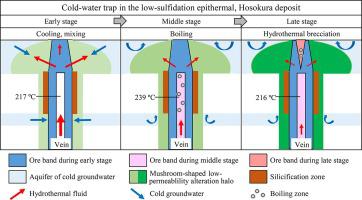当前位置:
X-MOL 学术
›
Ore Geol. Rev.
›
论文详情
Our official English website, www.x-mol.net, welcomes your
feedback! (Note: you will need to create a separate account there.)
A Cold-Water Trap as an Essential Process for the Generation of Low-Sulfidation Epithermal Deposits: Geological and Numerical Studies of the Hosokura Deposit, Northern Japan
Ore Geology Reviews ( IF 3.2 ) Pub Date : 2021-01-01 , DOI: 10.1016/j.oregeorev.2020.103780 Hiroshi Takahashi , Shohei Albert Tomita , Katsuaki Koike , Hiroo Yoshiyama
Ore Geology Reviews ( IF 3.2 ) Pub Date : 2021-01-01 , DOI: 10.1016/j.oregeorev.2020.103780 Hiroshi Takahashi , Shohei Albert Tomita , Katsuaki Koike , Hiroo Yoshiyama

|
Abstract Although low-sulfidation epithermal deposits, including the Hosokura deposit (Ag–Pb–Zn) in the Miyagi Prefecture, northern Japan, are globally significant metal sources, their ore deposition mechanisms are not thoroughly understood . This study aimed to construct a genetic ore deposition model for this deposit by focusing on the richest vein, the Fuji, and test the model using a numerical simulation of the formation and transitions of this fossil geothermal system. It was proposed that the mixing of neutral hydrothermal fluids (~260 °C) ascending through the vein with oxygenated cold groundwater caused early stage mineralization and the transport of hydrothermal fluids into the surrounding host rocks, forming a hydrothermal alteration halo around the vein that results in silicification, adularia alteration, and argillization. The progress of this alteration decreased the permeability of the halo and generated a mushroom-shaped low-permeability alteration halo (LPAH) in permeable zones surrounding the vein. The low-permeability and insulating properties of the LPAH increased the fluid temperature, the vein fluid boiled, and consequently the middle stage mineralization occurred. After a further decrease in LPAH permeability, hydrothermal brecciation resulting from increasing fluid pressure occurred at the top of the vein, resulting in late-stage mineralization. A TOUGH2 numerical simulation tested these proposed processes: early stage cooling of hydrothermal fluids by mixing with groundwater, the development of vapor in the vein by the formation of an LPAH during the middle stage, and an increase in fluid pressure leading to hydrothermal brecciation during the late-stage. The results of the simulation confirmed that a cold-water trap is an essential process for the generation of low-sulfidation epithermal deposits. Mushroom-shaped LPAHs, silicification zones, and brecciated veins caused by cold-water traps have been found in representative low-sulfidation epithermal deposits in Japan, such as the richest Au deposit, the Hishikari. Therefore, identification of cold-water-trap footprints can contribute to the exploration of this type of deposit.
中文翻译:

冷水圈闭是生成低硫化超热液矿床的必要过程:日本北部细仓矿床的地质和数值研究
摘要 虽然包括日本北部宫城县细仓矿床 (Ag-Pb-Zn) 在内的低硫化超热液矿床是全球重要的金属来源,但其矿石沉积机制尚不清楚。本研究旨在通过关注最丰富的矿脉富士山脉来构建该矿床的成因矿石沉积模型,并使用该化石地热系统的形成和转变的数值模拟来测试该模型。有人提出,通过静脉上升的中性热液(~260°C)与含氧的冷地下水混合导致早期矿化和热液输送到周围的主岩中,在静脉周围形成热液蚀变晕,导致在硅化、泥质改变和泥质化中。这种蚀变的进展降低了晕的渗透性,并在静脉周围的渗透区产生了蘑菇形的低渗透性蚀变晕(LPAH)。LPAH的低渗透性和绝缘性使流体温度升高,脉液沸腾,从而发生中期矿化。LPAH渗透率进一步降低后,在脉顶发生流体压力增加导致的热液角砾岩化,导致后期成矿。TOUGH2 数值模拟测试了这些提议的过程:早期通过与地下水混合冷却热液,在中期通过形成 LPAH 在静脉中发展蒸汽,后期流体压力增加导致热液角砾岩化。模拟结果证实,冷水阱是生成低硫化超热液沉积物的必要过程。在日本具有代表性的低硫化低温热液矿床中发现了蘑菇形 LPAH、硅化带和由冷水圈闭引起的角砾状脉,例如最丰富的金矿床 Hishikari。因此,识别冷水圈闭足迹有助于勘探此类矿床。由冷水圈闭引起的角砾状脉和角砾状脉在日本代表性的低硫化低温热液矿床中被发现,例如最丰富的金矿床 Hishikari。因此,识别冷水圈闭足迹有助于勘探此类矿床。由冷水圈闭引起的角砾状脉和角砾状脉在日本代表性的低硫化低温热液矿床中被发现,例如最丰富的金矿床 Hishikari。因此,识别冷水圈闭足迹有助于勘探此类矿床。
更新日期:2021-01-01
中文翻译:

冷水圈闭是生成低硫化超热液矿床的必要过程:日本北部细仓矿床的地质和数值研究
摘要 虽然包括日本北部宫城县细仓矿床 (Ag-Pb-Zn) 在内的低硫化超热液矿床是全球重要的金属来源,但其矿石沉积机制尚不清楚。本研究旨在通过关注最丰富的矿脉富士山脉来构建该矿床的成因矿石沉积模型,并使用该化石地热系统的形成和转变的数值模拟来测试该模型。有人提出,通过静脉上升的中性热液(~260°C)与含氧的冷地下水混合导致早期矿化和热液输送到周围的主岩中,在静脉周围形成热液蚀变晕,导致在硅化、泥质改变和泥质化中。这种蚀变的进展降低了晕的渗透性,并在静脉周围的渗透区产生了蘑菇形的低渗透性蚀变晕(LPAH)。LPAH的低渗透性和绝缘性使流体温度升高,脉液沸腾,从而发生中期矿化。LPAH渗透率进一步降低后,在脉顶发生流体压力增加导致的热液角砾岩化,导致后期成矿。TOUGH2 数值模拟测试了这些提议的过程:早期通过与地下水混合冷却热液,在中期通过形成 LPAH 在静脉中发展蒸汽,后期流体压力增加导致热液角砾岩化。模拟结果证实,冷水阱是生成低硫化超热液沉积物的必要过程。在日本具有代表性的低硫化低温热液矿床中发现了蘑菇形 LPAH、硅化带和由冷水圈闭引起的角砾状脉,例如最丰富的金矿床 Hishikari。因此,识别冷水圈闭足迹有助于勘探此类矿床。由冷水圈闭引起的角砾状脉和角砾状脉在日本代表性的低硫化低温热液矿床中被发现,例如最丰富的金矿床 Hishikari。因此,识别冷水圈闭足迹有助于勘探此类矿床。由冷水圈闭引起的角砾状脉和角砾状脉在日本代表性的低硫化低温热液矿床中被发现,例如最丰富的金矿床 Hishikari。因此,识别冷水圈闭足迹有助于勘探此类矿床。











































 京公网安备 11010802027423号
京公网安备 11010802027423号